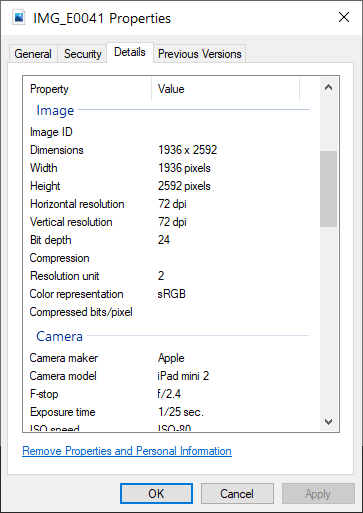Open AAE File
Information, tips and instructions
Exif Data
Exif is a metadata format specifically designed for storing metadata about images taken by digital cameras, smartphones and scanners. Exif was initially introduced by Japan Electronic Industries Development Association (JEIDA) in 1998. Multiple versions were introduced later with 2.32 released on May 17, 2019. Exif standard is supported by most of the digital camera vendors.
Exif data is typically stored inside of the file generated by digital camera. It contains multiple sections of the data including:
- Geolocation data. It includes latitude, longitude, altitude.
- Image optical data. It includes optical details like focal length, lens, max aperture value, exposure and more.
- Image digital data. It includes image size, resolution and color depth.
- Output sharpening applied to the image.
- Watermark information.
- Lens information. It includes lens maker, lens specificatin and lens serial number.
Besides the information added by the camera, more information could be added by the image editing. software like Adobe Lightroom. This includes:
- Title and description of the photo
- Copyright information
- Image rating
Image editing software like Adobe Lightroom also allows to change any Exif information associated with the image.
When transferring images from the digital camera it is possible to remove Exif information. This is typically done by converting native digital camera image format to JPEG, PNG or GIF. Sometimes it may be necessary to do it before publishing image online to preserve privacy of the person who created the image.
Below is an example of Windows File Explorer properties dialog with Exif data displayed.

As a conclusion it is important to know that Exif data is a key piece of information included in the image file produced by digital camera. It is important to know that you can either keep or remove this information and modify it if necessary. Depending on situation in which image was taken you may want to remove some or all the information in Exif data. On the opposite, sometimes it may be necessary to publish or even add Exif data to make sure that image authoring is known, and copyright is preserved.
| AAE Quick Info | |
|---|---|
 Apple Image Sidecar File Apple Image Sidecar File | |
| MIME Type | |
 not applicable not applicable
| |
| Opens with | |
 Apple iOS and iPadOS Apple iOS and iPadOS | |
 Apple Photos Apple Photos | |
 Apple iCloud Apple iCloud |
